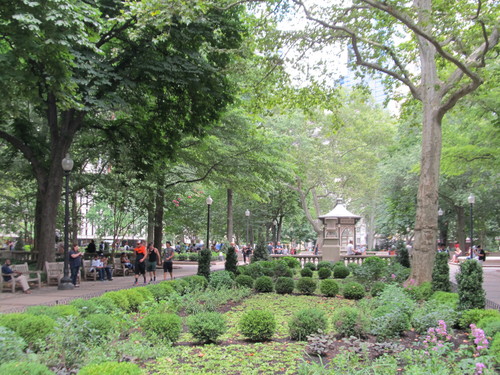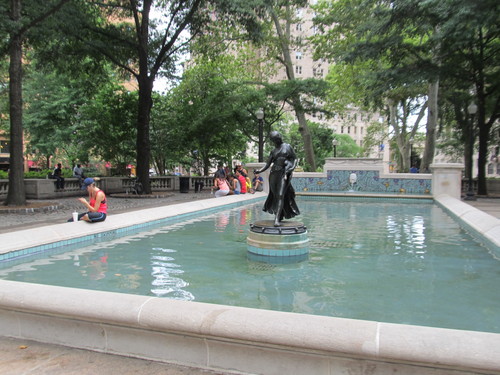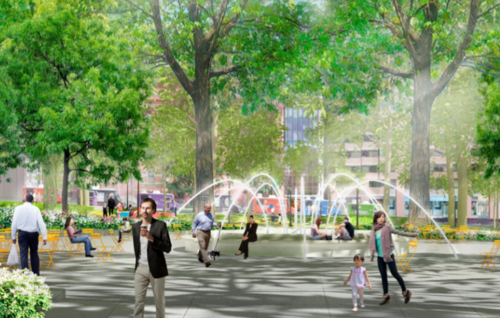This square in Philadelphia is everything DC’s Franklin Square could be
Many celebrate Philadelphia’s Rittenhouse Square as one of America’s best small urban parks. I visited this summer and found it alive with activity. It’s a great model for DC’s similarly-sized Franklin Square, which the National Park Service is currently redesigning.
Rittenhouse Square has long had a reputation as an exceptional park. Jane Jacobs lionized it, highlighting the park’s wide variety of users over the course of a typical day, in her famous 1961 book, The Death and Life of Great American Cities. She said that the fact that many different types of users with different schedules passed through the park was essential to making it feel like a safe and appealing environment, unlike the other Philadelphia parks she described as “a pervert park” and “a skid row park”.
I visited Rittenhouse Square in the early afternoon on a Friday in late July, and while I didn’t stay long enough to see a change in the park’s users, I did see quite a variety of people there, including businesspeople in suits eating lunch, people walking dogs, several people doing yoga and other exercises, a couple of buskers, teenagers socializing, and an artist painting the scene.
This wide variety of users is supported, in part, by the diverse uses in the neighborhood directly abutting the park. A number of small restaurants line the streets facing the park, as do a church, a hotel, a large Barnes & Noble bookstore, a clothing store, and condominiums. The neighboring blocks include several other large churches, but also a wide variety of restaurants and stores and a number of condominiums and office buildings.
Could Franklin Square become DC’s Rittenhouse?
Although DC contains plenty of parkland—much of it controlled by the National Park Service— a common complaint is that the city has a shortage of good urban parks that attract a variety of users from the local community.
Franklin Square, which consists of just under five acres between K and I Streets in downtown DC, is similar in size to Rittenhouse Square, which is seven acres a few blocks south of Market Street in downtown Philadelphia.
However, despite their similarities in size and location, the two parks couldn’t be more different. They both date to the early 1800s and were both vibrant urban parks in the early 20th Century, but Franklin Park began to decay and fell into disuse as the rise of the automobile changed land use patterns in the District. Rittenhouse Square, on the other hand, continued to be well-used.
Part of the reason for the difference in the parks’ fate may be the differences in their neighborhoods. While Franklin Square is located in a dense downtown neighborhood, it is largely surrounded by office buildings and businesses that cater to office workers, such as restaurants that are mainly open for breakfast and lunch. This means that while it does attract office workers looking for an outdoor location to eat lunch, few others have reason to go there. A lack of nearby residences, shopping, and public buildings means that there is little to draw people to the park on weekends, or on weekdays outside of the lunch hour.
The differing state of maintenance of the two parks likely plays a role as well. Franklin Square’s last major redesign was completed in 1935, when the current fountain, plaza, and pathways were installed. There was one major refurbishment in 1976 for the Bicentennial, but the park has not been well-maintained by the National Park Service, which owns and maintains the property, since.
Rittenhouse Square, on the other hand, has been well-maintained. The park is owned by the City of Philadelphia, but many recent improvements, including better lighting, landscaping, restoration of the park’s fountains, and the installation and stocking of dispensers for bags that dog owners can use to pick up after their animals have been projects of a non-profit called Friends of Rittenhouse Square that works with Philadelphia Parks and Recreation to maintain and operate the park.
Franklin Square redesign plans
Although little can be done about the disadvantages of Franklin Square’s location—-the high demand for downtown office space produces high rents and pushes out most other uses—-there is hope for improvements to the park itself.
An $18 million joint project between the National Park Service, the DC government, and the Downtown Business Improvement District to renovate the park and provide year-round programming is set to begin construction in January 2017. The planned renovations include a cafe, improvements to the fountain at the park’s center, and a play area for children.
One day, Franklin Square might look like this:





